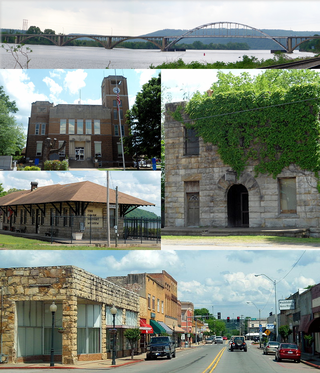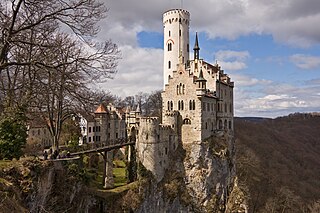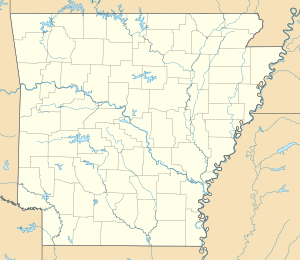
Medieval fortification refers to medieval military methods that cover the development of fortification construction and use in Europe, roughly from the fall of the Western Roman Empire to the Renaissance. During this millennium, fortifications changed warfare, and in turn were modified to suit new tactics, weapons and siege techniques.

The Château d'Angers is a castle in the city of Angers in the Loire Valley, in the département of Maine-et-Loire, in France. Founded in the 9th century by the Counts of Anjou, it was expanded to its current size in the 13th century. It is located overhanging the river Maine. It is a listed historical monument since 1875. Now open to the public, the Château d'Angers is home of the Apocalypse Tapestry.

Ozark is a city in Franklin County, Arkansas, United States and one of the county's two seats of government. The community is located along the Arkansas River in the Arkansas River Valley on the southern edge of the Ozark Mountains. As of the 2010 census it had a population of 3,684.

Experimental archaeology is a field of study which attempts to generate and test archaeological hypotheses, usually by replicating or approximating the feasibility of ancient cultures performing various tasks or feats. It employs a number of methods, techniques, analyses, and approaches, based upon archaeological source material such as ancient structures or artifacts.

The Ozarks, also known as the Ozark Mountains, Ozark Highlands or Ozark Plateau, is a physiographic region in the U.S. states of Missouri, Arkansas, Oklahoma and the extreme southeastern corner of Kansas. The Ozarks cover a significant portion of northern Arkansas and most of the southern half of Missouri, extending from Interstate 40 in central Arkansas to Interstate 70 in central Missouri.

Nottingham Castle is a Stuart Restoration-era ducal mansion in Nottingham, England, built on the site of a Norman castle built starting in 1068, and added to extensively through the medieval period, when it was an important royal fortress and occasional royal residence. In decline by the 16th century, the original castle, except for its walls and gates, was demolished after the English Civil War in 1651. The site occupies a commanding position on a natural promontory known as "Castle Rock" which dominates the city skyline, with cliffs 130 feet (40 m) high to the south and west.

Krak des Chevaliers, is a medieval castle in Syria and one of the most important preserved medieval castles in the world. The site was first inhabited in the 11th century by Kurdish troops garrisoned there by the Mirdasids. In 1142 it was given by Raymond II, Count of Tripoli, to the order of the Knights Hospitaller. It remained occupied by them until it was reconquered by the Muslims in 1271.

Königstein Fortress, the "Saxon Bastille", is a hilltop fortress near Dresden, in Saxon Switzerland, Germany, above the town of Königstein on the left bank of the River Elbe. It is one of the largest hilltop fortifications in Europe and sits atop the table hill of the same name.

Dogpatch USA was a theme park located in northwest Arkansas along State Highway 7 between the cities of Harrison and Jasper, an area known today as Marble Falls. It was based on the comic strip Li'l Abner, created by cartoonist Al Capp and set in a fictional village called Dogpatch. The park opened in 1968, and closed in 1993.

Lichtenstein Castle is a privately owned Gothic Revival castle located in the Swabian Jura of southern Germany. It was designed by Carl Alexander Heideloff and its name means "shining stone" or "bright stone". The castle overlooks the Echaz valley near Honau, Reutlingen in the state of Baden-Württemberg. The modern castle was inspired by Wilhelm Hauff's 1826 novel Lichtenstein and was built in 1840–1842. The ruins of an older medieval castle are a few hundred meters away.

Camelot Theme Park was a resort and theme park located in the English county of Lancashire. The park's theme was the well-known legend of Camelot, and the park decor incorporated pseudo-medieval elements. It was located on a 140-acre site near the village of Charnock Richard, 3 miles (4.8 km) west of Chorley. The site was owned by The Story Group and was operated by Knights Leisure. The park featured many rides, taking a target audience of families and younger children; however, the park also boasted numerous thrill rides and roller coasters, including Whirlwind, Knightmare and Excalibur. On 4 November 2012, Knight’s Leisure announced that they would not be reopening for the season of 2013.

Guédelon Castle is a castle currently under construction near Treigny, France. The castle is the focus of an experimental archaeology project aimed at recreating a 13th-century castle and its environment using period techniques, dress, and materials.

The Cittadella, also known as the Castello, is the citadel of Victoria on the island of Gozo, Malta. The area has been inhabited since the Bronze Age, and the site now occupied by the Cittadella is believed to have been the acropolis of the Punic-Roman city of Gaulos or Glauconis Civitas.

The Skopje Fortress, commonly referred to as Kale, is a historic fortress located in the old town of Skopje, the capital of North Macedonia. It is located in Centar municipality and situated on the highest point in the city overlooking the Vardar River. The fortress is depicted on the coat of arms of Skopje, which in turn is incorporated in the city's flag.

Reconstruction in architectural conservation is the returning of a place to a known earlier state by the introduction of new materials. It is related to the architectural concepts of restoration and preservation, wherein the most extensive form of reconstruction is creating a replica of a destroyed building.

Corfe Castle is a fortification standing above the village of the same name on the Isle of Purbeck peninsula in the English county of Dorset. Built by William the Conqueror, the castle dates to the 11th century and commands a gap in the Purbeck Hills on the route between Wareham and Swanage. The first phase was one of the earliest castles in England to be built at least partly using stone when the majority were built with earth and timber. Corfe Castle underwent major structural changes in the 12th and 13th centuries.

A treadwheel crane is a wooden, human powered hoisting and lowering device. It was primarily used during the Roman period and the Middle Ages in the building of castles and cathedrals. The often heavy charge is lifted as the individual inside the treadwheel crane walks. The rope attached to a pulley is turned onto a spindle by the rotation of the wheel thus allowing the device to hoist or lower the affixed pallet.

Duncarron is a modern reproduction of a fortified village from the early Middle Ages of Scotland. It is the reconstruction of a typical residence of a Scottish clan chief from the early part of the last millennium. The supporter is the nonprofit organization The Clanranald Trust for Scotland, whose chairman is Charlie Allan. Duncarron is located in the Carron Valley on the eastern end of the Carron Valley Reservoir, near Stirling. The medieval village is being built with the help of volunteers from all walks of life, and is intended to preserve and disseminate Scottish culture and heritage through education, active participation and entertainment.

Campus Galli is a Carolingian monastic community under construction in Meßkirch, Baden-Württemberg, Germany. The construction project includes plans to build a medieval monastery according to the early ninth-century Plan of Saint Gall using techniques from that era. The long-term financing of the project is to come from revenue generated from the site's operation as a tourist attraction. The construction site has been open for visitors since June 2013.

Secrets of the Castle, or Secrets of the Castle with Ruth, Peter and Tom is a British factual television series that first broadcast on BBC Two from 18 November to 17 December 2014. The series stars archaeologists Peter Ginn and Tom Pinfold, and historian Ruth Goodman. In the series, the team takes part in the medieval construction project at Guédelon Castle in Treigny, France. During their stay there, they reveal what kind of skills and crafts were needed to build a castle in the 13th century, by using the techniques, tools and materials of the era.





















